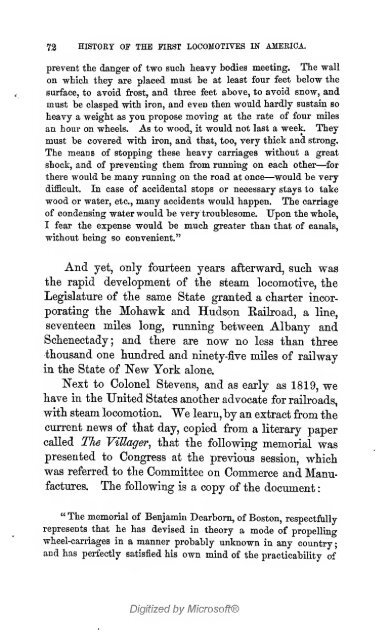The history of the first locomotives in America. From original ...
The history of the first locomotives in America. From original ...
The history of the first locomotives in America. From original ...
Create successful ePaper yourself
Turn your PDF publications into a flip-book with our unique Google optimized e-Paper software.
73<br />
HISTORY OF THE FIRST LOCOMOTIVES IN AMERICA.<br />
prevent <strong>the</strong> danger <strong>of</strong> two such heavy bodies meet<strong>in</strong>g. <strong>The</strong> wall<br />
on which <strong>the</strong>y are placed must be at least four feet below <strong>the</strong><br />
surface, to avoid frost, and three feet above, to avoid snow, and<br />
must be clasped with iron, and even <strong>the</strong>n would hardly susta<strong>in</strong> so<br />
heavy a weight as you propose mov<strong>in</strong>g at <strong>the</strong> rate <strong>of</strong> four miles<br />
an hour on wheels. As to wood, it would not last a week. <strong>The</strong>y<br />
must be covered with iron, and that, too, very thick and strong.<br />
<strong>The</strong> means <strong>of</strong> stopp<strong>in</strong>g <strong>the</strong>se heavy carriages without a great<br />
shock, and <strong>of</strong> prevent<strong>in</strong>g <strong>the</strong>m from runn<strong>in</strong>g on each o<strong>the</strong>r— ^for<br />
<strong>the</strong>re would be many runn<strong>in</strong>g on <strong>the</strong> road at once—would be very<br />
difficult. In case <strong>of</strong> accidental stops or necessary stays to take<br />
wood or water, etc., many accidents would happen. <strong>The</strong> carriage<br />
<strong>of</strong> condens<strong>in</strong>g water would be very troublesome. Upon <strong>the</strong> whole,<br />
I fear <strong>the</strong> expense would be much greater than that <strong>of</strong> canals,<br />
without be<strong>in</strong>g so convenient."<br />
And yet, only fourteen years afterward, sucli was<br />
tlie rapid development <strong>of</strong> <strong>the</strong> steam locomotive, tlie<br />
Legislature <strong>of</strong> tlie same State granted a charter <strong>in</strong>cor-<br />
porat<strong>in</strong>g <strong>the</strong> Mohawk and Hudson Eailroad, a l<strong>in</strong>e,<br />
seventeen miles long, runn<strong>in</strong>g "between Albany and<br />
Schenectady; and <strong>the</strong>re are now no less than three<br />
thousand one hundred and n<strong>in</strong>ety-five miles <strong>of</strong> railway<br />
<strong>in</strong> <strong>the</strong> State <strong>of</strong> New York alone.<br />
Next to Colonel Stevens, and as early as 1819, we<br />
have <strong>in</strong> <strong>the</strong> United States ano<strong>the</strong>r advocate for railroads,<br />
with steam locomotion. We learn, hj an extract from <strong>the</strong><br />
current news <strong>of</strong> that day, copied from a literary paper<br />
called <strong>The</strong> Villager^ that <strong>the</strong> follow<strong>in</strong>g memorial was<br />
presented to Congress at <strong>the</strong> previous session, which<br />
was referred to <strong>the</strong> Committee on Commerce and Manufactures.<br />
<strong>The</strong> follow<strong>in</strong>g is a copy <strong>of</strong> <strong>the</strong> document<br />
" <strong>The</strong> memorial <strong>of</strong> Benjam<strong>in</strong> Dearborn, <strong>of</strong> Boston, respectfully<br />
represents that he has devised <strong>in</strong> <strong>the</strong>ory a mode <strong>of</strong> propell<strong>in</strong>g<br />
wheel-carriages <strong>in</strong> a manner probably unknown <strong>in</strong> any country<br />
and has perfectly satisfied his own m<strong>in</strong>d <strong>of</strong> <strong>the</strong> practicability <strong>of</strong><br />
Digitized by Micros<strong>of</strong>t®<br />
:<br />
;
















